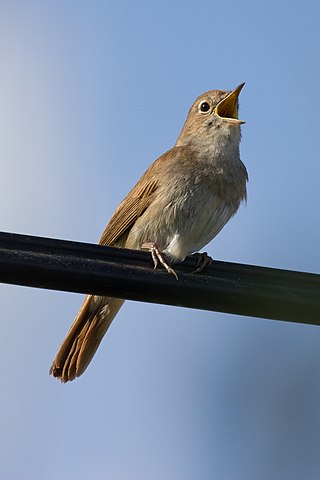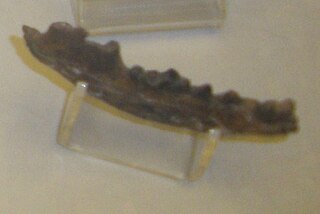
The thrush nightingale, also known as the sprosser, is a small passerine bird that was formerly classed as a member of the thrush family Turdidae, but is now more generally considered to be an Old World flycatcher, Muscicapidae. It, and similar small European species, are often called chats.

The common nightingale, rufous nightingale or simply nightingale, is a small passerine bird which is best known for its powerful and beautiful song. It was formerly classed as a member of the thrush family Turdidae, but is now more generally considered to be an Old World flycatcher, Muscicapidae. It belongs to a group of more terrestrial species, often called chats.

Cranmore is a village on the Isle of Wight. It is located about three miles east of Yarmouth, in the northwest of the island. It is in the civil parish of Shalfleet.

Luscinia is a genus of smallish passerine birds, containing the nightingales and relatives. Formerly classed as members of the thrush family Turdidae, they are now considered to be Old World flycatchers (Muscicapidae) of the chat subfamily (Saxicolinae). The chats are a lineage of Old World flycatchers that has evolved convergently to thrushes.

Pannonictis is a genus of extinct mustelids. It is first known from the very Late Pliocene and survived until the end of the Villafranchian, and is most commonly recorded from deposits between 2.6 and 1.4 Ma. Remains of Pannonictis have been found throughout Eurasia, from the Iberian Peninsula to eastern China.

Felis wenzensis is an extinct species of cat that was described based on fossils from the Pliocene-aged Węże 1 locality in Poland. It is known from only one specimen, a partial left mandibular ramus, and is distinguished from the closely-related felines Felis lunensis and Felis silvestris by its larger teeth.
Carduelis parvulus is an extinct species of Carduelis that inhabited Hungary during the Neogene period.
Carduelis lambrechti is an extinct species of Carduelis that inhabited Hungary during the Neogene period.
Saxicola baranensis is an extinct species of Saxicola that inhabited Hungary during the Neogene period.
Saxicola magna is an extinct species of Saxicola that inhabited Hungary during the Neogene period.
Calandrella gali is an extinct species of Calandrella that inhabited Hungary during the Neogene period.
Erithacus minor is an extinct species of Erithacus that inhabited Hungary during the Neogene period.
Luscinia denesi is an extinct species of Luscinia that inhabited Hungary during the Neogene period.
Lanius intermedius is an extinct species of Lanius that inhabited Hungary during the Neogene period.
Lullula parva is an extinct species of Lullula that inhabited Hungary during the Neogene period.
Phylloscopus pliocaenicus is an extinct species of Phylloscopus that inhabited Hungary during the Neogene period.
Emberiza pannonica is an extinct species of Emberiza that inhabited Hungary during the Neogene period.
Delichon major is an extinct species of Delichon that inhabited Hungary during the Neogene period.
Cettia janossyi is an extinct species of Cettia that inhabited Hungary during the Neogene period.
Muscicapa miklosi is an extinct species of Old World flycatcher: a passerine bird in the genus Muscicapa that inhabited Hungary during the Neogene period.





